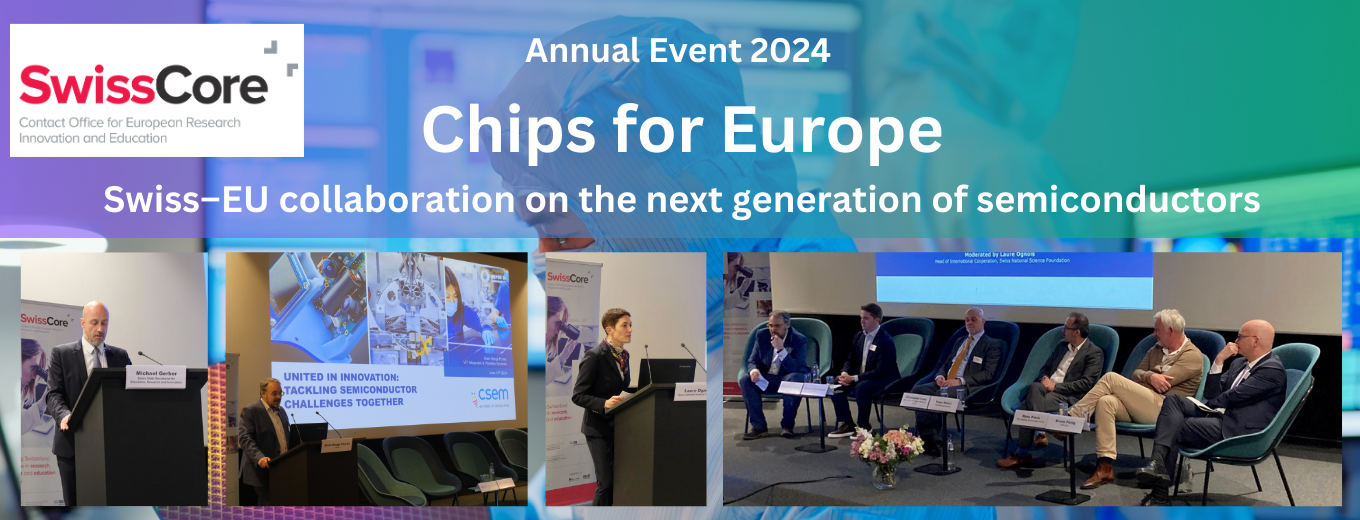Speakers discussed strategies to strengthen its microchip supply chain and competitiveness by taking advantage of Europe’s R&I strengths while bridging research and industry.
The SwissCore 2024 Annual Event served as a platform for discussing Europe’s path to reclaim its place in the development and production of microchips, the “bedrock of modern technology”, from high-power computing to renewable energy systems, to managing complex health and transportation networks, present in virtually every aspect of our daily lives. In his welcome address, Ambassador Michael Gerber, Director General of International Programmes & Organisations at SERI, emphasised the importance of Swiss reassociation to Horizon Europe and EU R&I programmes as well as the readiness for Switzerland to integrate the microchip development landscape via its parallel initiatives, a very highly skilled workforce trained through institutions like EPFL and ETH Zurich, the participation of SMEs and research organisations.
The imperative of improving Europe’s position in the microchip production and supply chain appeared as a central topic during the panel. Every component of this value chain, from electronic design automation and core intellectual property blocks to Fabs, wafers, and ATP (assembly, testing, and packaging) is indispensable. Any bottleneck poses a severe threat to the stability and efficiency of the entire chain. Some panellists contended that Europe cannot feasibly invest in every element of this chain, as it lacks competitive advantage in several areas though Europe possesses certain strengths that can be strategically leveraged in key sectors. Other panellists mentioned the importance of investing in diverse parts of the value chain, including fabs, to preserve a degree of European autonomy. Consequently, it is crucial for Europe to foster collaboration among other players in key areas of the supply chain, capitalising on its competitive strengths. Switzerland, notably, has the capability to address specific gaps in the European microchip development chain, particularly in advancing future microchip technologies. Thus, expediting Swiss association is in everyone’s best interest, as it will facilitate essential collaboration.
The importance of a well-balanced and collaborative ecosystem, requiring strong linkages between academia and industry in which R&D efforts flow seamlessly between fundamental science and real-world applications, was also identified as a key component needed to foster innovation and competitivity in tomorrow’s European chip industry. Industrial feedback helps shape research projects to address market needs, while academic research fuels long-term advancements making it crucial to bring companies closer to where the researchers are. Success in this domain hinges on several key factors with combined public and private investment being essential for sustained innovation, nurturing technological progress, European industrial growth, and global competitiveness. Universities collaborating with PhD students on cutting-edge projects exemplify the synergy needed to translate early-stage research into practical applications. Many of the panellists agreed that Europe must strive for global leadership in advanced scientific and technological fields, not just keeping pace but pushing the boundaries of innovation in areas like microelectronics and semiconductor production.
Panellists, including Alain-Serge Porret (CSEM) stressed the crucial role of public-private partnerships. CSEM, with its focus on higher Technology Readiness Levels (TRLs), bridges the gap between research and industrial application. Porret explained that this synergy between research institutions and industry is essential in the process of translating innovation into tangible products and that a skilled workforce is a cornerstone of success. Mattias Björnmalm (CESAER) pointed to the importance of attracting and retaining top talent throughout the career pipeline, from early researchers to experienced professionals and building greater competitiveness through institutional instruments, such as a Competitiveness Council. In turn, Yasin Ekinci (PSI) highlighted the unique advantage of large research facilities as these infrastructures can handle big-budget projects and work in collaboration with companies in international consortia, fostering knowledge transfer and talent development. Ekinci explained that the obstacle to microchip autonomy does not lie in the technological and technical know-how but rather in the costs; making it consequently necessary to play to strengths we have in the European R&I space and do-away with “techno-nationalism”. Hans Priem (VDL) emphasised that Europe can carve out a niche by addressing specific gaps in the chip development value chain. Collaboration with international partners like Switzerland is crucial for achieving this goal. The discussion also highlighted the need for strategic planning and long-term vision. Christopher Lang, Deputy Director of the Representation of the Free State of Saxony to the EU, from a region with a thriving microchip industry often referred to as “Silicon Saxony”, highlighted the importance of consistent investment and a supportive policy environment while cautioning against a one-time funding approach, emphasising the need for sustained efforts in the long-term. Bruno Paing (CEA-Leti) also highlighted the need for streamlining regulations to facilitate collaboration and accelerate innovation.
The panellists acknowledged the rapidly evolving technological landscape stressing the need for “exponential problem-solving,” which will involve embracing new approaches like AI-powered solutions to optimise resource allocation, workforce training and development and supportive policy framework. All in all, the event demonstrated that Europe’s chip future hinges on a collaborative, well-resourced, and adaptable approach. By leveraging its research strengths, fostering talent, and building strategic partnerships, Europe can close the gap and claim a place as a leader in chip developments technology.

